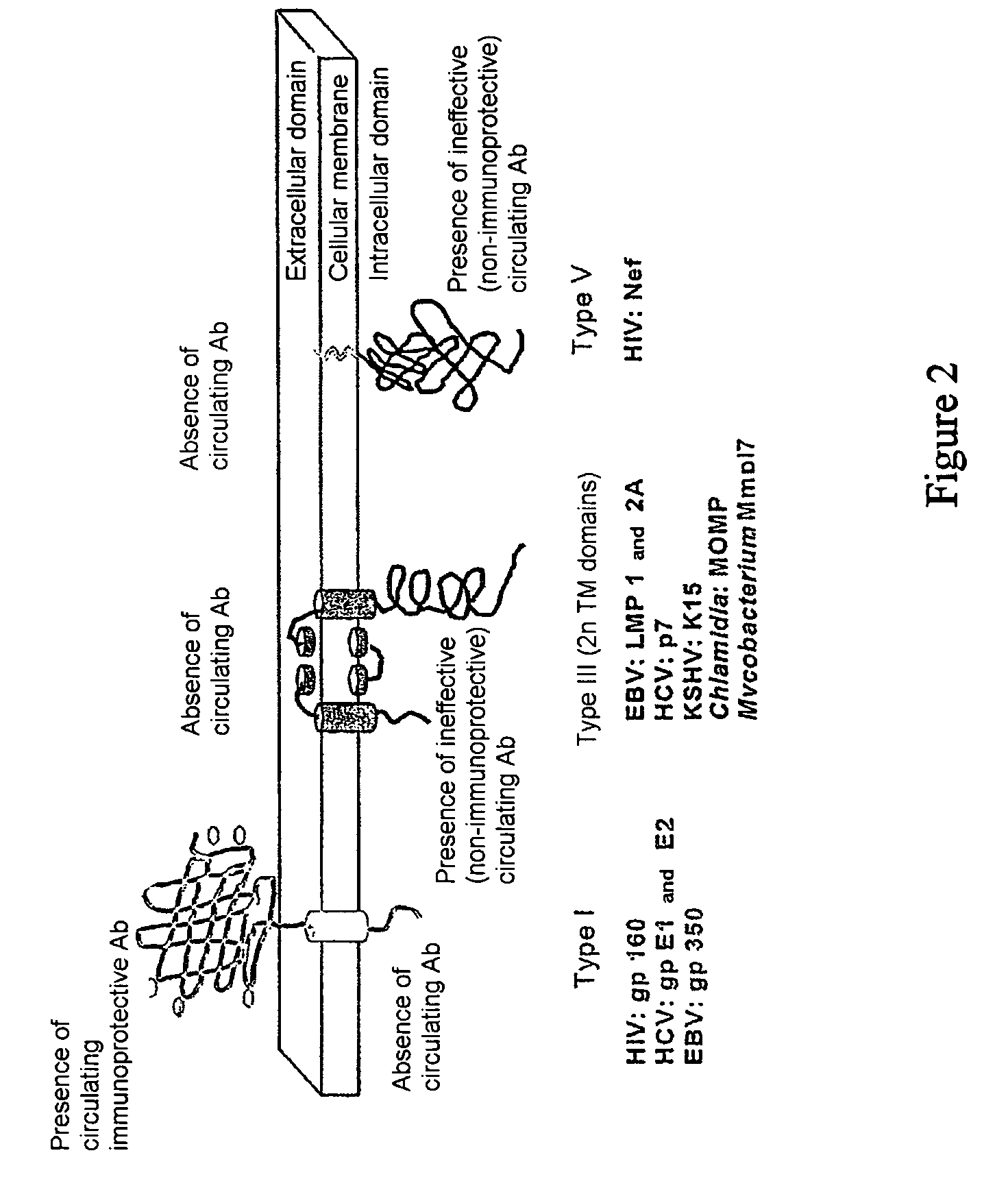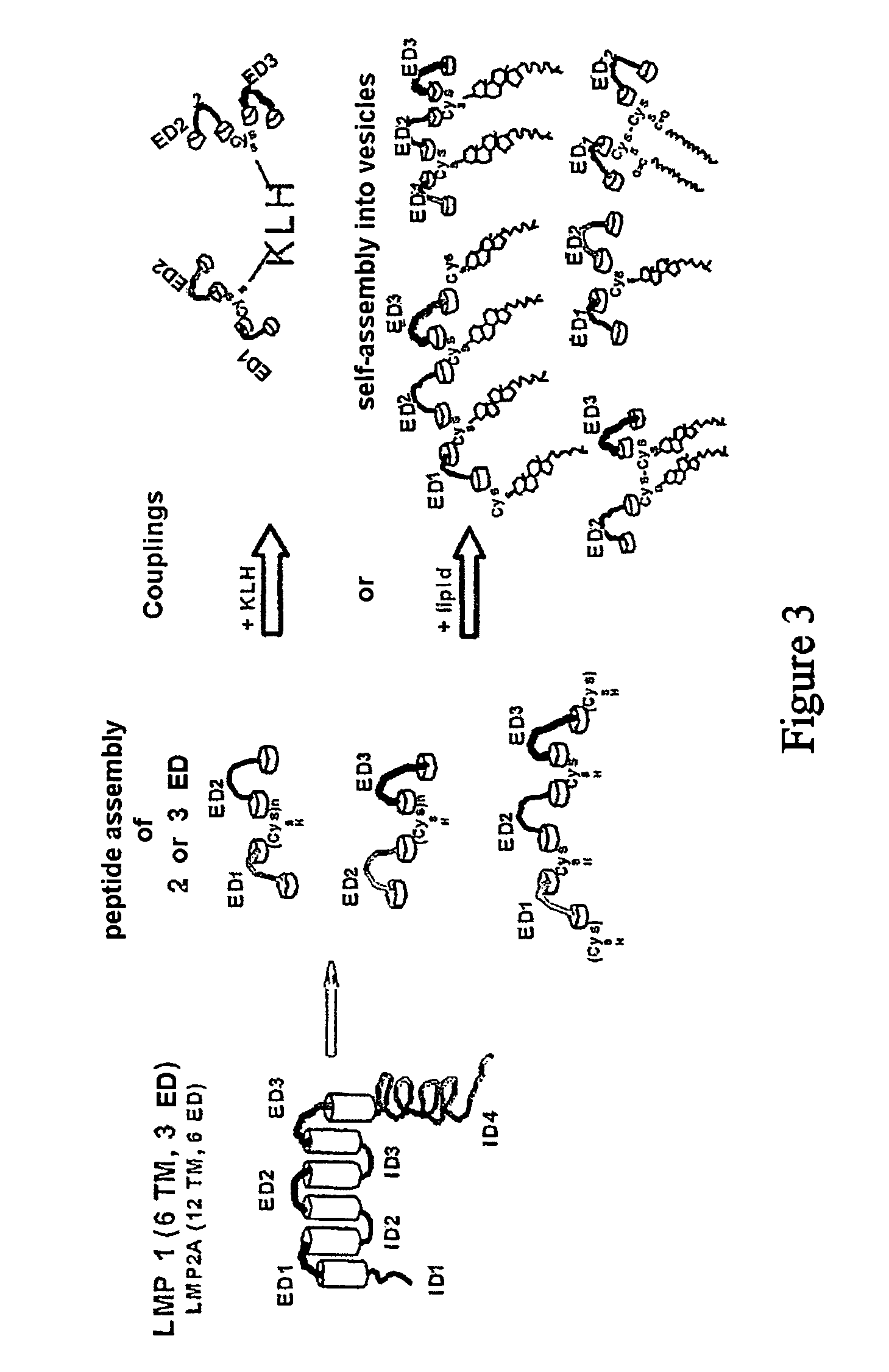Antigen imitating extracellular areas of membrane proteins of type III produced from intracellular pathogenic micro-organisms, derived conformational antibodies and the use thereof
a technology of membrane proteins and conformational antibodies, which is applied in the direction of viruses, peptides, drug compositions, etc., can solve the problems of difficult to carry out, high cost and labor, and compromising the host's ability to control the proliferation of ebv-infected cells, etc., to achieve effective elimination of infected cells, high cytolytic and pro-apoptotic activity, and simple use
- Summary
- Abstract
- Description
- Claims
- Application Information
AI Technical Summary
Benefits of technology
Problems solved by technology
Method used
Image
Examples
example 2
Preparation of Conformational Antibodies Directed Against the Extracellular Domains of the EBV LMP1 Protein
[0135]Antibodies directed against the extracellular domains of the EBV LMP1 protein were prepared by immunization of mice with the peptides SEQ ID Nos 10 and 11 coupled to KLH, or else with the peptide SEQ ID No. 13 coupled to cholesterol, as described in example 1. The kinetics of appearance of the serum antibodies directed against the extracellular domains of the LMP1 protein were analyzed by ELISA, as described in example 1.
[0136]The results illustrated in FIG. 5 and in table II show that the antigens according to the invention are immunogenic, i.e. they induce the production of antibodies directed against the extracellular domains of the LMP1 protein when they are administered in vivo to an individual.
[0137]
TABLE IIImmunogenic potency of the antigensImmuno-IdentifiergenicPeptideSequenceNumberPotencyLMP1DomainMSDWTGGALLWNLHGQALSEQ ID No:+++1 + 210DomainLWNLHGQALLYLQQNWWTSEQ ...
example 3
Analysis of the Specificity and of the Affinity of the Anti-LMP1 Antibodies
[0138]The specificity and the affinity of the antibodies produced as described in examples 1 and 2 are measured using the competition assay, as described in example 1.
[0139]The results obtained with the antibodies directed against the antigen representing the concatenation of the extracellular domains ED1 and ED2, separated by a cysteine residue (antigen (ED1+ED2), SEQ ID NO. 10), are illustrated respectively in FIGS. 6 and 7.
[0140]The absence of competition with the peptide (ED1+ED3) demonstrates:[0141]firstly, that the antibodies recognize the antigen (ED1+ED2) specifically (FIG. 6), and[0142]secondly, since these antibodies, that are polyclonal in nature (immune serum), show no reactivity with the peptide ED1+ED3, which has the ED1 sequence in common with the antigen (ED1+ED2), these results also indicate that the antibodies are conformational antibodies, given that they specifically recognize a noncontigu...
example 4
Analysis of the Reactivity of the Antibodies with Respect to the Native or Denatured LMP1 Protein
[0144]The reactivity of the mouse immune sera prepared as described in examples 1.3 and 2, with respect to the native or denatured LMP1 antigen, is tested by immunocytochemistry, as described in example 1.7. Alternatively, the reactivity of the sera is tested by Western blotting (denaturing conditions), according to standard protocols known in themselves or by immunoprecipitation (native conditions), as described in example 1.9.
[0145]The results illustrated in FIGS. 8, 9 and 10 demonstrate that the mouse immune sera contain conformational antibodies that sensitively and specifically recognize the native LMP1 protein expressed at the surface of cells from patients suffering from latent infection with EBV, by immunocytochemistry (cells fixed under nondenaturing conditions as specified in example 1.7) and by immunoprecipitation (cell lysates prepared under nondenaturing conditions); on the ...
PUM
| Property | Measurement | Unit |
|---|---|---|
| pH | aaaaa | aaaaa |
| pH | aaaaa | aaaaa |
| pH | aaaaa | aaaaa |
Abstract
Description
Claims
Application Information
 Login to View More
Login to View More - R&D
- Intellectual Property
- Life Sciences
- Materials
- Tech Scout
- Unparalleled Data Quality
- Higher Quality Content
- 60% Fewer Hallucinations
Browse by: Latest US Patents, China's latest patents, Technical Efficacy Thesaurus, Application Domain, Technology Topic, Popular Technical Reports.
© 2025 PatSnap. All rights reserved.Legal|Privacy policy|Modern Slavery Act Transparency Statement|Sitemap|About US| Contact US: help@patsnap.com



